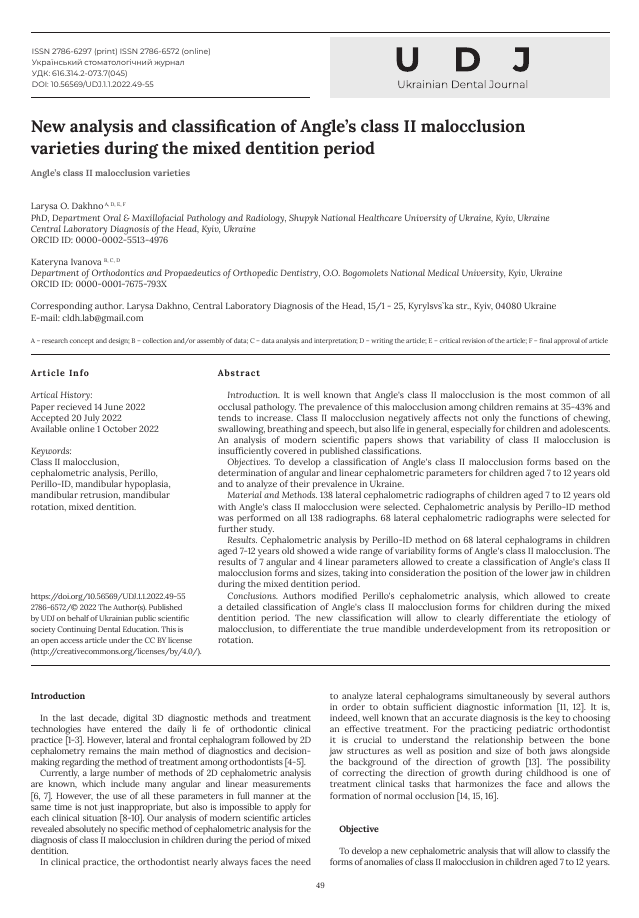Новий цефалометричний аналіз та класифікація патології прикусу класу ІІ за Енглем в періоді змішаного прикусу
varieties during the mAngle’s cl
DOI:
https://doi.org/10.56569/UDJ.1.1.2022.49-55Ключові слова:
Патологія прикусу, II клас за Енглем, цефалометричний аналіз, Perillo, Perillo-ID, гіпоплазія нижньої щелепи, ретрузія нижньої щелепи, ротація нижньої щелепи, змішаний прикусАнотація
Вступ. Загальновідомо, що неправильний прикус по ІІ класу за Енглем є найпоширенішим серед усіх оклюзійних патологій. Поширеність такої патології прикусу серед дітей залишається на рівні 35-43% і має тенденцію до зростання. Аномалія прикусу ІІ класу негативно впливає не тільки на функції жування, ковтання, дихання і мови, а й на якість життя в цілому, особливо дітей та підлітків. Аналіз сучасних наукових праць показує, що варіабельність неправильного прикусу II класу за Енглем недостатньо висвітлена в опублікованих класифікаціях.
Мета. Розробити класифікацію форм неправильного прикусу II класу за Енглем на основі визначення кутових та лінійних цефалометричних показників у дітей 7-12 років та проаналізувати їх поширеність в Україні.
Матеріали та методи. Відібрано 138 бічних цефалометричних рентгенограм дітей віком від 7 до 12 років з неправильним прикусом по II класу за Енглем. На всіх 138 рентгенограмах проведено цефалометричне вимірювання методом Perillo-ID. Для подальшого дослідження відібрано 68 бічних цефалометричних рентгенограм.
Результати. Цефалометричний аналіз за методом Perillo-ID на 68 бічних цефалограмах у дітей 7-12 років показав широкий діапазон варіабельності форм неправильного прикусу по II класу за Енглем. Результати семи кутових та чотирьох лінійних параметрів дозволили створити класифікацію форм неправильного прикусу II класу за Енглем з урахуванням положення і розміру нижньої щелепи у дітей у періоді змішаного прикусу.
Висновки. Автори модифікували цефалометричний аналіз Perillo , що дозволило створити детальну класифікацію форм неправильного прикусу ІІ класу за Енглем у дітей в період змішаного прикусу. Нова класифікація дозволить чітко диференціювати етіологію неправильного прикусу, диференціювати справжній недорозвиток нижньої щелепи від її ретропозиції або ротації.
Посилання
Kang T-J, Eo S-H, Cho H.J, Donatelli RE, Lee S-J. A sparse principal component analysis of Class III malocclusions. Angle Orthod 2019; 89(5): 768-774. doi: https://doi.org/10.2319/100518-717.1
Chen S, Wang L, Li G, et al. Machine learning in orthodontics: introducing a 3D auto-segmentation and auto-landmark finder of CBCT images to assess maxillary constriction in unilateral impacted canine patients. Angle Orthod 2020; 90(1): 77-84. doi: https://doi.org/10.2319/012919-59.1
Au J, Mei L, Bennani F, Kang A, Farell M. Three-dimensional analysis of lip changes in response to simulated maxillary incisor advancement. Angle Orthod 2020; 90(1): 118-124. doi: https://doi.org/10.2319/022219-134.1
Moon JH, Hwang HW, Lee SJ. Evaluation of an automated superimposition method for computer-aided cephalometrics. Angle Orthod 2020; 90:390–396. doi: https://doi.org/10.2319/071319-469.1
Suh HY, Lee HJ, Lee YS, Eo SH, Donatelli RE, Lee SJ. Predicting soft tissue changes after orthognathic surgery: the sparse partial least squares method. Angle Orthod 2019; 89: 910–916. doi: https://doi.org/10.2319/120518-851.1
Durão AR, Bolstad N, Pittayapat P, Lambrichts I, Ferreira AP, Jacobs R. Accuracy and reliability of 2D cephalometric analysis in orthodontics. Rev Port Estomatol Med Dent Cirurgia Maxilofac 2014; 55(3):135-41. doi: https://doi.org/10.1016/j.rpemd.2014.05.003
Durão AR, Pittayapat P, Rockenbach MI, Olszewski R, Ng S, Ferreira AP, Jacobs R. Validity of 2D lateral cephalometry in orthodontics: a systematic review. Prog Orthod 2013; 14(1):31. doi: https://doi.org/10.1186/2196-1042-14-31
Yoon KS, Lee HJ, Lee SJ, Donatelli RE. Testing a better method of predicting postsurgery soft tissue response in Class II patients: a prospective study and validity assessment. Angle Orthod 2015; 85: 597–603. doi: https://doi.org/10.2319/052514-370.1
Suh H-Ye, Lee Sh-J, Lee Yu-S, et al. A more accurate method of predicting soft tissue changes after mandibular setback surgery. J Oral Maxillofac Surg 2012; 70: e553–562. doi: https://doi.org/10.1016/j.joms.2012.06.187
Lee HJ, Suh HY, Lee YS, et al. A better statistical method of predicting postsurgery soft tissue response in Class II patients. Angle Orthod 2014; 84: 322–328. doi: https://doi.org/10.2319/050313-338.1
Wang S, Li H, Li J, Zhang Y, Zou B. Automatic analysis of lateral cephalograms based on multiresolution decision tree regression voting. J Healthc Eng 2018; 2018:1797502. doi: https://doi.org/10.1155/2018/1797502.
Damstra J, Fourie Z, Ren Y. Evaluation and comparison of postero-anterior cephalograms and cone-beam computed tomography images for the detection of mandibular asymmetry. Eur J Orthod 2013; 35(1):45-50. doi: https://doi.org/10.1093/ejo/cjr045
Songra G, Mittal TK, Williams JC, Puryer J, Sandy JR, Ireland AJ. Assessment of growth in orthodontics. Orthod Update 2017; 10(1):16-23. doi: https://doi.org/10.12968/ortu.2017.10.1.16
Kök H, Izgi MS, Acilar AM. Determination of growth and development periods in orthodontics with artificial neural network. Orthod Craniofac Res 2021; 24:76-83. doi: https://doi.org/10.1111/ocr.12443
Jheon AH, Oberoi S, Solem RC, Kapila S. Moving towards precision orthodontics: An evolving paradigm shift in the planning and delivery of customized orthodontic therapy. Orthod Craniofac Res 2017; 20:106-13. doi: https://doi.org/10.1111/ocr.12171.
Yassir YA, Salman AR, Nabbat SA. The accuracy and reliability of WebCeph for cephalometric analysis. J Taibah Univ Med Sci 2022; 17(1):57-66. doi: https://doi.org/10.1016/j.jtumed.2021.08.010.
Mahto RK, Kafle D, Giri A, Luintel S, Karki A. Evaluation of fully automated cephalometric measurements obtained from web-based artificial intelligence driven platform. BMC Oral Health. 2022; 22(1):132. doi: https://doi.org/10.1186/s12903-022-02170-w
Perillo L, Padricelli G, Isola G, Femiano F, Chiodini P, Matarese G. Class II malocclusion division 1: a new classification method by cephalometric analysis. Eur J Paediatr Dent 2012; 13(3): 192-6.
Phulari B. An atlas on cephalometric landmarks. JP Medical Ltd; 2013.
Todorova-Plachiyska KG, Stoilova-Todorova MG. Lateral cephalometric study in adult Bulgarians with normal occlusion. Folia Med (Plovdiv) 2018; 60(1):141-146. doi: https://doi.org/10.1515/folmed-2017-0072
Al-Jasser NM. Cephalometric evaluation for Saudi population using the Downs and Steiner analysis. J Contemp Dent Pract 2005; 6(2):52-63.
Mishra P, Pandey CM, Singh U, Gupta A, Sahu C, Keshri A. Descriptive statistics and normality tests for statistical data. Ann Card Anaesth 2019; 22(1):67-72. doi: https://doi.org/10.4103/aca.ACA_157_18
Alhammadi MS, Halboub E, Fayed MS, Labib A, El-Saaidi C. Global distribution of malocclusion traits: A systematic review. Dental Press J Orthod 2018; 23(6), 40.e1–40.e10. doi: https://doi.org/10.1590/2177-6709.23.6.40.e1-10.onl
Flis P, Ivanova K, Dakhno L. The prevalence of malocclusions in children aged 6-13 years living in Кyiv and Kyiv region. Ukrainian Dental Almanac 2021; 4: 42-47.
Tulloch JFC, Phillips C, Koch G, Proffit W.. The effect of early intervention on skeletal pattern in Class II malocclusion: a randomized clinical trial. Am J Orthod Dentofacial Orthop 1997; 111: 391–400. doi: https://doi.org/10.1016/s0889-5406(97)80021-2
Tulloch JFC, Proffit WR, Phillips C. Outcomes in a 2-phase randomized clinical trial of early Class II treatment. Am J Orthod Dentofacial Orthop 2004; 125: 657–667. doi: https://doi.org/10.1016/j.ajodo.2004.02.008
O'Brien K, Wright J, Conboy F, et al. Early treatment for Class II Division 1 malocclusion with the Twin-block appliance: a multi-center, randomized, controlled trial. Am J Orthod Dentofacial Orthop 2009; 135: 573–579. doi: https://doi.org/10.1016/j.ajodo.2007.10.042
Oh H, Baumrind S, Korn E. L, et al. A retrospective study of Class II mixed-dentition treatment. Angle Orthod 2017; 87(1): 56–67. doi: https://doi.org/10.2319/012616-72.1

Завантаження
Опубліковано
Номер
Розділ
Категорії
Ліцензія
Авторське право (c) 2022 The Author(s)

Ця робота ліцензується відповідно до ліцензії Creative Commons Attribution 4.0 International License.








